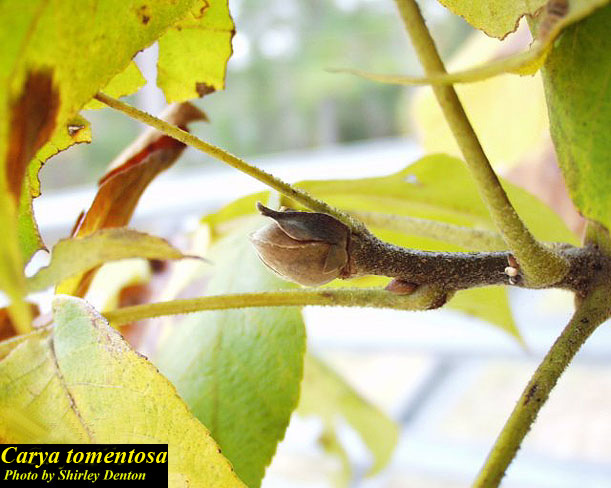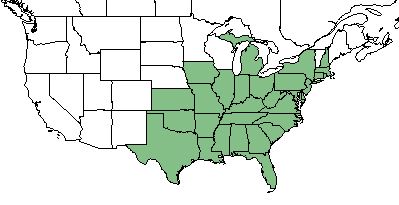Carya tomentosa
Common name: Mockernut Hickory; White Hickory
| Carya tomentosa | |
|---|---|

| |
| Photo by the Atlas of Florida Plants Database | |
| Scientific classification | |
| Kingdom: | Plantae |
| Division: | Magnoliophyta - Flowering plants |
| Class: | Magnoliopsida - Dicots |
| Order: | Juglandales |
| Family: | Juglandaceae |
| Genus: | Carya |
| Species: | C. tomentosa |
| Binomial name | |
| Carya tomentosa Lam. | |

| |
| Natural range of Carya tomentosa from USDA NRCS Plants Database. | |
Contents
Taxonomic Notes
Synonyms: Carya alba (L.) Nuttall ex Elliott, Hicoria alba (L.) Britton
Varieties: none
Description
C. tomentosa, also known as mockernut hickory, is a native perennial in the Juglandaceae family.[1] A large tree that normally reaches heights of 50-60 feet, but can reach heights up to 100 feet in good soil. Bark has a net-like pattern which is rough and thin with narrow ridges and shallow furrows. Leaves pinnately compound, deciduous, and turn golden-yellow in the fall. Undersurface of leaves densely covered with soft hairs. Nuts are small and barely edible, and are inside a thick, large shell.[2]
Distribution
The species can be found throughout most of Eastern United States, ranging from Texas and Kansas to New Hampshire and Michigan [1].
Ecology
Habitat
C. tomentosa can be found in forests and woodlands including communities ranging from mesic hammocks to pine sandhills.[3][4] More specifically, the habitats range from mixed hardwood forests, disturbed meadows, in sandy soil of mesic woods, rich deciduous woods, hardwood hammocks, wooded ravines, and loamy sand woodlands.[5] It has been found to decrease in frequency in areas that are managed for red-cockaded woodpeckers.[6]
Associated species: Pinus palustris, Quercus hemisphaerica, Quercus incana, Quercus falcata, Quercus virginiana, and Quercus laevis [3].
Phenology
C. tomentosa is known to flower in April.[2] Fruit has been seen to be present from March to May and July as well as the month of October. [5]
Seed dispersal
C. tomentosa is dispersed through various mammals found in the pine sandhills community [7].
Seed bank and germination
For propagation purposes, C. tomentosa is easily grown from fresh seeds that are sown either immediately from collection or stratified first and sown in the spring. The nuts should be collected between September and November when the tree is fruiting, and embryo dormancy is possible to overcome by moist stratification between 33 and 40 degrees for a duration of 30 to 150 days. This is since older seeds need less stratification.[2]
Fire ecology
Species in the Carya genus have been found to colonize sites when fire becomes absent in areas that were once burned and dominated by longleaf pine.[8]
Use by animals
It serves as a larval host for some moths, including the Luna moth (Actias luna), the funeral dagger (Acronicta funeralis), and the giant regal (Citheronia regalis). The tree as a whole attracts birds and butterflies. For humans, the wood is used for flooring, furniture, baseball bats, tool handles, veneer, and skis. Hickory wood is also utilized for both firewood and charcoal, and is preferred for smoking ham.[2]
Diseases and parasites
Trees that are stressed are more susceptible to hickory bark beetle.[2]
Conservation and Management
Cultivation and restoration
Photo Gallery
References and notes
- ↑ 1.0 1.1 USDA Plants Database URL: https://plants.usda.gov/core/profile?symbol=CATO6
- ↑ 2.0 2.1 2.2 2.3 2.4 [[1]] Lady Bird Johnson Wildflower Center. Accessed: April 2, 2019
- ↑ 3.0 3.1 Heuberger, K. A. and F. E. Putz (2003). "Fire in the suburbs: ecological impacts of prescribed fire in small remnants of longleaf pine (Pinus palustris) sandhill." Restoration Ecology 11: 72-81.
- ↑ Weakley, A. S. (2015). Flora of the Southern and Mid-Atlantic States. Chapel Hill, NC, University of North Carolina Herbarium.
- ↑ 5.0 5.1 Florida State University Robert K. Godfrey Herbarium database. URL: http://herbarium.bio.fsu.edu. Last accessed: June 2018. Collectors: Cecil R. Slaughter, Travis MacClendon, Karen MacClendon, Cindi Stewart, Loran C. Anderson, R. K. Godfrey, Gwynn W. Ramsey, R. S. Mitchell, Donald E. Stone, R. Kral, Victoria I. Sullivan, Patricia Elliott, H. Kurz, and Palmer Kinser. States and counties: Florida: Nassau, Washington, Leon, Wakulla, Jackson, Liberty, Suwannee, Gadsden, Calhoun, and Alachua.
- ↑ Bowman, J. L., et al. (1999). Effects of red-cockaded woodpecker management on vegetative composition and structure and subsequent impacts on game species. Proceedings of the Fifty-third Annual Conference, Southeastern Association of Fish and Wildlife Agencies. A. G. Wong, P. Doerr, D. Woodward, P. Mazik and R. Lequire. Greensboro, NC, Southeastern Association of Fish and Wildlife Agencies: 220-234.
- ↑ Myster, R. W. and S. T. A. Pickett (1993). "Effects of litter, distance, density and vegetation patch type on post dispersal tree seed predation in old fields." Oikos 66: 381-388.
- ↑ Archer, J. K., et al. (2007). "Changes in understory vegetation and soil characteristics following silvicultural activities in a southeastern mixed pine forest." Journal of the Torrey Botanical Society 134: 489-504.